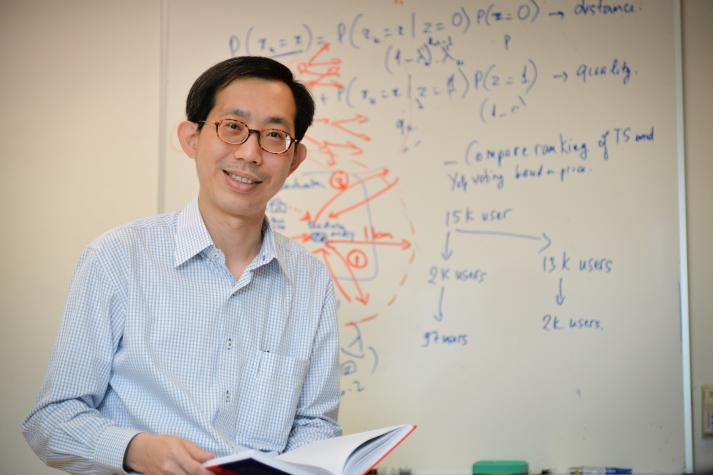
Professor Lim Ee Peng from the SMU School of Information Systems turns Twitter noise into useful and informative data.

Photo Credit: Cyril Ng
By Rebecca Tan
SMU Office of Research (11 Aug 2014) – Internet users from the 1990s would remember the hum and whirr of a modem dial-up connection. At that time, access to the Internet was a novel and exciting possibility, even if the static webpages and blinking Graphics Interchange Formats (GIFs) feel horribly dated now. Not so long ago, those without a Personal Computer (PC) in their homes would have to go to an Internet cafe. These days, we would expect cafes to offer free Wi-Fi.
In short, it is easy to dismiss the ubiquity of mobile phones as nothing short of a digital revolution, says Professor Lim Ee Peng from the Singapore Management University (SMU) School of Information Systems. Professor Lim, who specialised in databases during his PhD study, now focuses on analysing social media to yield valuable insights.
“In the early days when machines were still inaccessible to many people, it was mostly the big companies such as banks and telcos that had the means to buy computers, develop applications, and use databases to store enterprise data. Today, we see everyone owning at least a desktop PC, and one or more mobile devices,” he says.
“These are all computers with the capability to compute and gather voluminous data. We are now in a situation where lots of data is available, be it personal data, or data about our friends and contacts. One major source of such publicly available data is social media, which have seen a lot of interesting research and innovation being conducted.”
Sifting out social media noise
But what exactly can all this data tell us? One application that most people might be familiar with is personalised search. Professor Lim cites the example of the search engine Google, which has used extensive data analytics to refine and customise its system such that searches are not only powerful but also personalised using social media signals. Social media can also improve recommendations for products and services, while allowing us to find the best way to navigate around a new city, he says.
However, before social media data can be used, there has to be a way to make sense of what is meaningful amidst the noise. Recognising this, Professor Lim has worked on developing ways to make use of social media data to identify interesting events that happen in the real world.
“Information now flows faster than ever before, and from sources outside mainstream media. What I have done, together with my research team, is to use social media data that is in the public domain to detect some events that could be of interest to the general user.”
“These could be events reported by Twitter users, generating interest in the short or long-term, depending on the nature of the event. We have developed algorithms to detect interesting events, and devised a system of summarising information according to the different events. These ultimately helped users make sense of the many Twitter postings generated by the event,” he says.
Apart from event detection, Professor Lim has also worked on identifying influential people within the Twitter network. With many thousands of users tweeting and re-tweeting contents, it was previously difficult to sift out which users were truly influential as originators of popular contents.
“Our approach is to define an influential user as someone who generates content that gets adopted by many other followers, as well as followers of the followers, thus perpetuating content diffusion. In addition, we are able to distinguish users based on the topic of the content, which gives a more appropriate measure of the person’s influence. For example, an influential user in the topic of electronic goods actually has more influence than someone who is influential in a more trivial topic,” he explains.
In 2010, Professor Lim and his co-authors published the TwitterRank model in the Association for Computing Machinery International Conference on Web Search and Data Mining. It has since been widely recognised and implemented.
Putting the social in social media studies
As befitting a social media researcher, Professor Lim has done much of his research collaboratively.
“Within the SMU School of Information Systems, I’ve collaborated with quite a few colleagues, largely in the fields of data and text mining,” he says. “I have also worked with colleagues from the School of Social Sciences (SOSS) and Lee Kong Chian School of Business on interdisciplinary topics.”
“One successful project was the study of Singapore’s haze problems last year. I collaborated with Associate Professor Christie Scollon from SOSS to analyse Twitter data generated by Singapore residents over June 2013 so as to understand what went on during the haze period, especially how it impacted their daily lives, and their responses to it.”
In particular, Professor Lim credits the contributions of his colleagues at the Living Analytics Research Centre (LARC) where he is the co-director.
“Since I’ve joined SMU, I have also helped to build a team of very talented researchers to develop research and technology that support a whole range of social media mining projects. We have already developed a suite of social media mining software called the Palanteer system, which helps people search, analyse and visualise Twitter data in real-time.”
“We have also initiated some research in the new area of online experimentation, where we are interested in conducting online experiments with users, so as to better understand their responses to different user interface designs, recommendation approaches and other services. We are beginning to engage social media users and consumers in various types of online experiments. Having managed to achieve all these as a team in the last three years is something that I am very proud of.”
Social media: here to stay
Not one to rest on his laurels, Professor Lim is excited about the possibilities in social media, both in the near future and the decades to come.
“I think it is going to grow further; we are just beginning to see the rise of social media at the scale of covering every city and country. There are still a lot of useful new applications that can be built on top of social media, just like in the early days of e-commerce where many things were happening on the new technology of the Web,” he notes.
“People are now participating in all kinds of interactions, directly engaging with companies and businesses in both social media and the physical world. I believe that all these activities will generate new data that can help us understand users as well as businesses, and ultimately, society as a whole.”
See More News
Want to see more of SMU Research?
Sign up for Research@SMU e-newslettter to know more about our research and research-related events!
If you would like to remove yourself from all our mailing list, please visit https://eservices.smu.edu.sg/internet/DNC/Default.aspx

